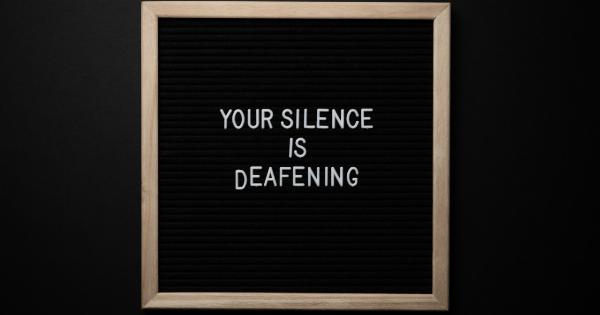Eliminating sugar from your diet can be a daunting task, but it comes with numerous health benefits. From improved weight management to reduced risk of chronic diseases, there are plenty of reasons to consider going sugarless.
However, just like any dietary change, eliminating sugar from your diet can lead to some uncomfortable withdrawal symptoms. In this article, we will explore nine common deprivation symptoms that you might experience when going sugarless and provide tips on how to manage them effectively.
1. Sugar Cravings
One of the most challenging aspects of going sugarless is the cravings you may experience. Sugar stimulates the brain’s reward system, similar to drugs or alcohol, leading to addiction-like cravings.
When you suddenly cut out sugar, your body will crave it even more. These cravings can be intense and difficult to resist.
2. Fatigue
Sugar is a quick source of energy, as it rapidly raises blood sugar levels. When you eliminate sugar, you might experience a temporary dip in energy levels. This fatigue can make it challenging to stay motivated and engaged throughout the day.
3. Headaches
Headaches are a common withdrawal symptom when eliminating sugar. Research suggests that the drop in blood sugar levels and changes in neurotransmitter levels during sugar withdrawal can trigger headaches.
4. Mood Swings
Sugar affects your mood by altering neurotransmitter levels in the brain, such as dopamine and serotonin. When you remove sugar from your diet, these neurotransmitter levels can become imbalanced, leading to mood swings and irritability.
5. Digestive Issues
Changing your diet abruptly can affect your digestive system. When you cut out sugar, you may experience digestive issues such as bloating, gas, and constipation.
This is because sugar can feed certain strains of gut bacteria, and their depletion can temporarily disrupt your digestive balance.
6. Low Immunity
Sugar can weaken your immune system, making you more susceptible to infections and illnesses. When you stop consuming sugar, your immune system may need time to readjust and strengthen.
During this adjustment period, you might experience more frequent bouts of illness.
7. Dizziness
Removing sugar from your diet can cause a drop in blood sugar levels, which can result in dizziness or lightheadedness. This symptom is more common in individuals who consume high amounts of sugar regularly.
8. Skin Breakouts
Sugar consumption has been linked to skin issues such as acne and inflammation. By eliminating sugar, you may initially experience skin breakouts as your body detoxifies, removing the accumulated toxins caused by sugar consumption.
9. Hunger Pangs
Sugar can affect your hunger and satiety hormones, leading to increased appetite. When you go sugarless, your body may take time to readjust these hormones, resulting in increased hunger pangs.
This can make it difficult to stick to your new sugarless lifestyle.
Now that you are aware of the potential deprivation symptoms when going sugarless, here are some tips to help you manage them effectively:.
Tips for Managing Sugar Deprivation Symptoms
1. Gradual Reduction
Instead of cutting out sugar abruptly, consider gradually reducing your consumption. This approach can help minimize the severity of withdrawal symptoms.
2. Stay Hydrated
Drinking plenty of water can help flush out toxins and reduce the intensity of withdrawal symptoms. It can also help reduce cravings and keep you feeling more energized.
3. Eat Balanced Meals
Focus on consuming balanced meals that include adequate protein, healthy fats, and complex carbohydrates. This can help stabilize blood sugar levels, reduce cravings, and provide sustained energy throughout the day.
4. Choose Natural Sweeteners
If you still crave sweetness, you can opt for natural sweeteners like stevia or monk fruit. While they may not have the same impact on blood sugar levels, it’s important to consume them in moderation.
5. Manage Stress
Stress can trigger sugar cravings and make withdrawal symptoms worse. Incorporate stress-management techniques such as meditation, yoga, or deep breathing exercises to help control cravings and reduce withdrawal symptoms.
6. Get Enough Sleep
Ensure you are getting adequate sleep as sleep deprivation can exacerbate cravings and make it harder to resist temptation. Aim for 7-9 hours of quality sleep each night.
7. Explore Healthy Alternatives
Find sugar-free alternatives and recipes that satisfy your cravings. Experiment with natural ingredients like fruits, spices, or healthy fats to make delicious treats without added sugars.
8. Seek Support
Enlist the support of friends, family, or online communities who are also striving to reduce their sugar intake. Sharing experiences and strategies can provide valuable insights and keep you motivated.
9. Focus on Long-Term Benefits
Remind yourself of the long-term benefits of going sugarless. Improved overall health, increased energy levels, and reduced risk of chronic diseases are all worth the temporary discomfort of withdrawal symptoms.
By implementing these tips, you can ease the transition into a sugarless lifestyle and navigate the deprivation symptoms effectively.






























